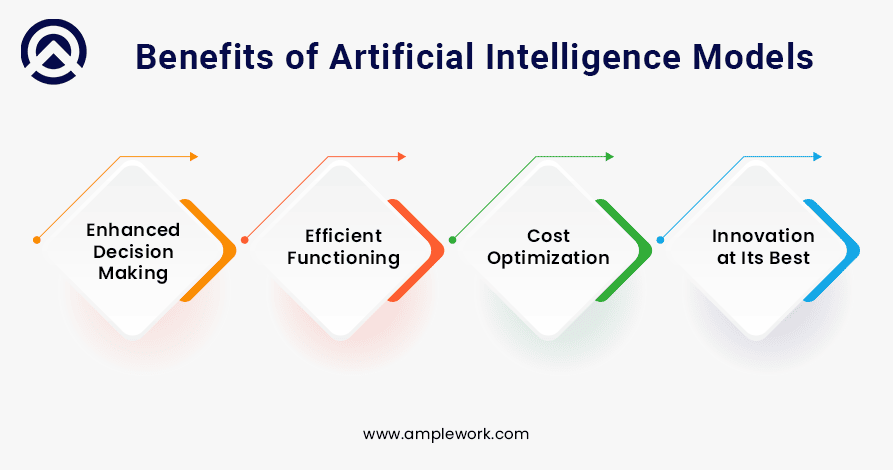A Guide to Know All About AI Models in 2025
Introduction
Do you want to know all about artificial intelligence models? If yes, this blog is for you! Here, we are going to discuss different kinds of AI models in-depth so that you can know every aspect of AI models and choose the right one that aligns with your business goals.
Artificial Intelligence is transforming not only businesses and industries but also every aspect of life. Nowadays, AI models are behind everything from movie recommendations to self-driving cars. These models use huge amounts of data to learn patterns, make decisions, and predict outcomes, and all that makes the best for businesses. Within a short period of time, AI models have transformed the ways businesses operate.
According to specifications, we can categorize artificial intelligence models into four types, and each one has its own specifications and is used for different purposes. In this blog, we are going to discuss each AI model in detail so you can know how they work, their advantages and limitations, and tools and technologies they use, and also their applications. Whether you want to clear all your doubts regarding AI models or you want to develop your own AI model, in both conditions, this blog will help you to clear all your doubts.
Let’s have a look at the key statistics of AI models that will help you to know how AI models are shaping the world.
Key Statistics and Insights That Highlights the Impact of AI Models
- According to Gartner, 90% of enterprises are integrating AI models into their operations, to improve data analysis and decision-making capabilities.
- According to Deloitte, 45% of businesses report that after implementing AI models, they have experienced a boost in customer personalization, engagement, and retention.
- According to Statista, the annual AI model revenues will amount to $60 billion in 2027.
- Accenture says 70% of fraud detection solutions in banks use AI models, which makes systems more secure and reduces risks.
- McKinsey found diagnoses were 20% more accurate and treatment costs were reduced by 15 percent with AI-based models in healthcare, therefore improving the wellbeing of the patient.
What is an Artificial Intelligence Model?
An AI model is a program that uses data to find patterns and make predictions, and it’s designed to simulate human thinking and learning. These models are mathematical representations of real-world processes that are trained using relevant data to act in real-world situations. AI models use algorithms to identify patterns and relationships within data, allowing them to automate tasks such as image recognition, language processing, and data analysis.
AI models are the backbone of technologies such as chatbots, recommendation engines, and autonomous systems. These range from simple regression algorithms to more complex deep-learning neural networks.
Key features of artificial intelligence models:
- The learning from data: AI models improve their performance over time by analyzing more data.
- Decision-making: The processes of decision-making are automated for AI models that are learned patterns.
- Generalization: AI models apply learned knowledge to unseen data.
What Are the Different Types of AI Models?
AI models are mainly categorized into four major types: supervised learning, unsupervised learning, reinforcement learning, and deep learning models. Each model is known for its kind of specifications and serves unique purposes, from making complex decisions to making predictions in dynamic environments.
1. Supervised Learning Models
Supervised learning is a type of machine learning in which models learn from labeled datasets. In this, every input has a corresponding known output. The idea is to train the model to predict outcomes with a good amount of accuracy by recognizing patterns in the data.
In supervised learning, models are trained using labeled datasets which means the model learns to map inputs to correct outputs based on minimizing errors. This technique is widely used in classification, such as spam detection, and regression applications, such as the prediction of stock prices.
To implement supervised learning models in your business operations, you can hire dedicated AI developers.
Types of Supervised Learning Models
A. Regression Models (Predicting Continuous Values)
Regression models use input data for the prediction of numerical values. These models often predict trends and prices or measurements and are found mainly in financial, health, and economics applications. They include stock price predictions, forecasting sales, or assessing risks in these fields.
1. Linear Regression
It predicts continuous values such as stock prices, home prices, and sales trends. Linear regression determines the best-fit line for the data so that one can make an accurate forecast.
2. Polynomial Regression
Polynomial regression is an extension of linear regression that captures more complex, non-linear relationships in the data. It is helpful in simulations, such as predicting the trajectory of moving objects.
B. Classification Models (Categorizing Data)
Classification models are the ones used for categorizing data into predefined labels. They can be used in the application fields such as spam detection, disease diagnosis, and sentiment analysis.
1. Logistic Regression
Logistic regression is used in the binary classification task where they need to detect spam emails or fraudulent transactions. They predict probabilities for assigning categories.
2. Support Vector Machines (SVM)
SVMs are strong classification models, particularly when handling high-dimensional image recognition, among other things. They look for the optimal boundary between categories to make the most accurate classification.
Advantages & Limitations of Supervised Learning Models
Here are the key benefits and limitations of supervised learning AI models.
| Aspect | Advantages | Limitations |
| Performance | High accuracy with quality data | Needs large labeled datasets |
| Interpretability | Simple models are easy to understand | Complex models require feature engineering |
| Scalability | Can be scaled with distributed computing | Large models require high computational power |
| Applications | Used in finance, healthcare, security | Struggles with noisy or imbalanced data |
Tools & Technologies for Supervised Learning
Here are the tools and technologies that are used in supervised learning.
| Category | Tools & Frameworks |
| Programming | Python, R, MATLAB |
| ML Libraries | scikit-learn, TensorFlow, PyTorch |
| Cloud Platforms | Google Cloud AI, AWS SageMaker, Azure ML |
| Data Processing | Pandas, NumPy, SciPy |
| Visualization | Matplotlib, Seaborn, Plotly |
Supervised learning can be used by businesses to automate processes and improve decision-making, but it requires high-quality data and computational resources to provide you with optimal performance. As AI continues to evolve, you may experience improvements in AutoML and edge AI that are currently improving its capabilities.
2. Unsupervised Learning Models
Unsupervised learning models use unlabeled data to find patterns and structures. Instead of predicting outcomes, they discover hidden relations in the data, so they can be used for clustering, anomaly detection, and data compression.
Unlike supervised learning, where models learn from known outputs, unsupervised learning finds patterns in data by grouping similar information, for instance, using segment customers in businesses along their shopping behavior without predefined categories.
Types of Unsupervised Learning Models
A. Clustering Models
Clustering models organize similar data points into groups according to common characteristics.
1. K-Means Clustering
It divides data into groups based on similarity. K-Means is profoundly utilized in customer segmentation and personalized recommendations.
For example: K-Means in e-commerce helps in grouping customers based on shopping habits that enables a business to personalize offers and marketing strategies. To enrich your business with clustering models, you can take the help of artificial intelligence consulting services.
2. Hierarchical Clustering
Hierarchical clustering creates a tree-like structure where the data points can easily be mapped. It can be applied to data that is necessary to be grouped hierarchically, such as genetic research.
3. DBSCAN (Density-Based Clustering)
DBSCAN identifies data based on density, which is useful for general types of noise, such as identifying instances of fraud. It does well with noisy data but performs less well in scenarios with drastically different densities.
B. Dimensionality Reduction Models
Dimensionality reduces complex high-dimensional data preserving all its original features. Their application enhances the computational process.
1. Principal Component Analysis (PCA)
PCA reduces the dimensionality of the data without losing most of the information that it holds. It is used in dimensionality reduction in images and in feature selection of artificial intelligence models.
2. t-SNE (t-Distributed Stochastic Neighbor Embedding)
This technique makes high-dimensional data visible by clumping similar data points together and is very useful in applications like medical imaging to classify diseases.
Tools and Technologies for Unsupervised Learning Models
This table helps you to know the tools and technologies that are used for unsupervised learning AI models.
| Category | Tools & Technologies | Use Case |
| Programming Languages | Python, R, Julia, MATLAB | Used for implementing unsupervised learning algorithms |
| Machine Learning Frameworks | TensorFlow, PyTorch, Scikit-learn, Keras | Provides built-in support for clustering & dimensionality reduction |
| Clustering Algorithms | K-Means, DBSCAN, Agglomerative Clustering | Used in customer segmentation, fraud detection |
| Dimensionality Reduction | PCA, t-SNE, UMAP (Uniform Manifold Approximation) | Reduces data dimensionality while preserving structure |
| Big Data Processing | Apache Spark MLlib, Dask, Hadoop | Handles large-scale unsupervised learning tasks |
| Graph-Based Clustering | NetworkX, Neo4j, GraphX (Apache Spark) | Identifies relationships in complex datasets |
| AutoML for Unsupervised Learning | H2O.ai, AutoKeras, Google Vertex AI | Automates model selection and hyperparameter tuning |
| GPU-Accelerated Learning | NVIDIA RAPIDS, cuML, TensorFlow-GPU | Enhances the performance of unsupervised learning on large datasets |
Advantages and Limitations of Unsupervised Learning Models
Here are the key benefits and limitations of unsupervised learning AI models.
| Advantages | Limitations |
| No need for labeled data | No clear performance benchmark |
| Discovers hidden patterns | Hard to interpret the results |
| Scales well to large datasets | Sensitive to noise and outliers |
Unsupervised learning is very important in artificial intelligence as it enables machines to discover patterns without any human intervention. These models have been the backbone of innovations from customer segmentation to fraud detection in industries.
3. Reinforcement Learning (RL) Models
Reinforcement learning is a process in which an AI agent interacts with an environment to learn to make decisions. In this process, the AI agent starts a state, performs certain actions, and receives feedback in the form of rewards. Over time, the AI agent learns which action is more fruitful to get the highest cumulative rewards. RL uses a policy (decision-making strategy) and evaluates actions using value functions or Q-values. The learning process continues until the agent optimizes its actions to achieve the best possible outcome in the given environment.
Reinforcement learning (RL) trains the agent to interact with the environment, learn from rewards or punishments, and optimize decision-making. Using trial and error, the agent balances exploration and exploitation to maximize long-term rewards by following a Markov decision process (MDP). Algorithms such as Q-learning, DQN, and PPO refine the agent’s strategy for dynamic environments.
Types of Reinforcement Learning AI Models
Reinforcement learning is broadly categorized into model-based RL and model-free RL depending upon whether the agent forms an internal representation or model of the environment. Another set of classifications is based on how the learning is done: value-based, policy-based, and actor-critic RL.
These models are transforming business innovatively, and you can also opt for these AI models to enhance your business efficiency. To successfully implement these models, you should take the help of an AI application development services provider.
| Type | Description | Example Algorithms |
| Model-Based RL | The agent builds an internal model of the environment and plans actions accordingly. | AlphaGo, Monte Carlo Tree Search (MCTS) |
| Model-Free RL | The agent learns directly from interactions without building an explicit model. | Deep Q-Network (DQN), Policy Gradient |
| Value-Based RL | The agent learns a value function to estimate the best action. | Q-Learning, DQN |
| Policy-Based RL | The agent directly learns an optimal policy without estimating value functions. | REINFORCE, Proximal Policy Optimization (PPO) |
| Actor-Critic RL | Combines value-based and policy-based approaches for improved learning. | Advantage Actor-Critic (A2C), Deep Deterministic Policy Gradient (DDPG) |
Advantages & Limitations of Reinforcement Learning
Here are the key benefits and limitations of the reinforcement learning AI model.
| Aspect | Advantages | Limitations |
| Performance | Learns optimal decision-making over time | Requires massive data and compute |
| Adaptability | Adapts to dynamic environments (e.g., robotics, trading) | Long training time and expensive simulations |
| Interpretability | Provides explainable reward-driven actions | Black-box behavior in deep RL |
| Scalability | Can be applied to complex real-world problems | Instability in policy learning |
Tools & Technologies for Reinforcement Learning
Here are the key tools and technologies that are used for reinforcement learning AI models.
| Category | Tools & Frameworks |
| Programming | Python, Julia, R |
| RL Libraries | OpenAI Gym, Stable-Baselines3, RLlib |
| Deep RL | TensorFlow, PyTorch, Keras-RL |
| Simulators | CARLA (autonomous driving), MuJoCo (robotics) |
| Cloud Platforms | AWS DeepRacer, Google Cloud AI |
Reinforcement learning models have dramatically changed the scope of applications such as robotics, finance, gaming, and autonomous systems, making it possible for agents to learn from interactions without explicit supervision. Challenges such as high computational requirements notwithstanding, advances in deep RL, distributed training, and meta-learning are making RL more scalable and efficient.
4. Deep Learning Models
Deep learning is one of the prime branches of machine learning, with its primary focus applied to the use of artificial neural networks to analyze, recognize patterns, and make decisions. It automatically extracts features from raw data with minimal need for any manual processing, making it highly effective in domains such as image recognition, NLP, and self-governing systems.
Deep learning functions by passing through the data multiple times to different layers of connected neurons. Every step helps enhance the understanding of data. This method learns through backpropagation and optimization algorithms: SGD, Adam. Activation functions have been used: ReLU, Sigmoid, and Softmax. They help in avoiding linearity and lead to capturing complex relationships.
Architectures such as CNN, RNN, and Transformers improve performance in all AI-powered applications.
Types of Deep Learning Models
Here’s the Types of Deep Learning Models section in a table format:
| Type | Description | Use Cases | Example Models |
| Feedforward Neural Networks (FNNs) | Basic neural networks where data flows in one direction, from input to output. | Classification, regression, function approximation. | Multi-Layer Perceptron (MLP) |
| Convolutional Neural Networks (CNNs) | Designed for image and spatial data processing, using convolutional layers to extract features. | Image recognition, object detection, and medical imaging. | AlexNet, VGG, ResNet |
| Recurrent Neural Networks (RNNs) | Handles sequential data by maintaining hidden states that retain the previous context. | Speech recognition, time series forecasting, NLP tasks. | LSTM, GRU, BiLSTM |
| Transformer Networks | Uses self-attention mechanisms for parallel processing of sequential data. | Machine translation, chatbots, AI content generation. | BERT, GPT, T5 |
| Generative Adversarial Networks (GANs) | Consists of a generator and discriminator competing to generate realistic data. | Image synthesis, deepfake generation, data augmentation. | DCGAN, StyleGAN, CycleGAN |
| Autoencoders | Learns efficient data representations by encoding and decoding input data. | Anomaly detection, data compression, denoising. | Variational Autoencoders (VAE), Sparse Autoencoders |
Tools & Technologies for Deep Learning
Here are the tools, technologies, and programming languages that are used in deep learning AI models.
| Category | Tools & Frameworks |
| Programming | Python, Julia, MATLAB |
| DL Frameworks | TensorFlow, PyTorch, Keras |
| Cloud Platforms | Google AI Platform, AWS SageMaker, Microsoft Azure ML |
| Visualization | TensorBoard, Matplotlib, Seaborn |
| Hardware | NVIDIA GPUs, TPUs, Intel AI Chips |
Advantages & Limitations of Deep Learning
Here, we have counted the benefits and limitations of the deep learning AI model so that you can clear all your doubts, and know whether this model aligns with your business goals or not.
| Aspect | Advantages | Limitations |
| Performance | Achieves state-of-the-art accuracy in complex tasks. | Requires large labeled datasets and computational resources. |
| Automation | Extracts feature automatically without manual intervention. | Hard to interpret decisions (black-box nature). |
| Scalability | Efficiently processes massive data using GPUs and TPUs. | Training deep networks is time-consuming. |
| Adaptability | Generalizes well for various real-world applications. | Prone to overfitting if not properly regularized. |
Deep learning has transformed AI with breakthroughs in computer vision, natural language processing, and autonomous systems. It does require huge amounts of data and computational resources, but advancements in transfer learning, federated learning, and edge artificial intelligence are increasing its efficiency and real-world applicability.
Also Read: Designing Intelligent AI Agents for Personalized Marketing Campaigns: A Step-by-Step Guide
Key Benefits of Artificial Intelligence Models

1. Enhanced Decision Making
AI models can analyze large datasets with high accuracy in a faster way which helps businesses to make informed decisions. With predictive analytics and data-driven insights, organizations can reduce human error and optimize strategies to enhance overall decision-making.
2. Efficient Functioning
AI models streamline operations, save time, and reduce costs by automating repetitive tasks. This way, businesses can focus on more strategic activities while artificial intelligence handles time-consuming and repetitive tasks to boost productivity and operational efficiency.
3. Cost Optimization
Businesses can use AI models to offer personalized recommendations and experiences to customers by analyzing their preferences, behaviors, and past interactions. This helps businesses to improve customer satisfaction and increased loyalty.
4. Innovation at Its Best
Artificial Intelligence models can scale with growing business demands. AI can flexibly grow without compromising performance or quality when it comes to handling more data, processing complex tasks, and expanding to new markets.
Why Choose Amplework for AI Model Development?
Amplework is a reputed AI model development company that has been offering its advanced and innovative AI-driven solutions around the world across industries. They have an experienced team of artificial intelligence experts who are well-versed in all the latest AI tools and technologies and offer you customized solutions that align with your business goals. With a proven track record, we have optimized a wide range of businesses with customized AI model solutions to automate tasks, improve decision-making, and enhance user experience. Our prime aim is to offer you secure and scalable solutions that can ensure smooth performance. If you also want to transform your business with advanced AI models, then share your business idea with Amplework and our AI consultants will guide you through every aspect, and you will be able to enrich your business with top-notch AI solutions.
Final Words
Within a short span of time, AI models have become the talk of the town due to their fruitful aspects. AI models are transforming industries and helping them to automate routine tasks, improve decision-making, and enhance user experience. There are different types of AI models, and each one has its pros and cons. But, by choosing the right AI model for your business, you can ensure success. As technologies are evolving at an alarming rate, we are experiencing a wide range of new advancements every day, so you should be aware of these advancements to leverage the full potential of AI models. We hope this blog helps you to know all kinds of AI models.
Also Read: Top 10 Machine Learning Frameworks in 2025
Frequently Asked Questions (FAQs)
What are the top 10 AI models in 2025?
- GPT-3.5
- DeepSeek
- Ada
- GPT-4o
- GPT-4
- DALL-E
- Whisper
- Curie
- Llama
- Davinci
How to choose the right AI model for your applications?
Here are the key factors that must be considered to choose the right AI model for your applications.
- Know the problem you want to solve
- Understand your data type and size
- Performance and scalability
- Deployment and integration
- Evaluate cost and resources
- Model complexity
- Compare different AI models
- Inference speed
How to develop an AI model?
Here is the step-by-step process to make an Artificial Intelligence model for beginners.
- Define the problem
- Collect data
- Prepare the data
- Select an algorithm
- Train the model
- Evaluate the model
- Fine-tune the model
- Deploy the model
- Monitor and maintain the model
To simplify this process, you can also hire an AI model development company that will develop artificial intelligence learning models for you and you will be able to achieve your business goals easily.
Where can I get pre-trained AI models for my project?
Here is the list of pre-trained AI models that can be used by you without training them from scratch.
- To write text – Hugging face, OpenAI, and Cohere
- To recognize images – TensorFlow Hub, YOLO, Meta’s detectron2
- To listen and transcribe – Mozilla DeepSpeech, OpenAI Whisper
- To write code – GitHub Copilot, TensorFlow Model Garden
All these AI models are very popular and known for their efficiency. You can choose them according to your business requirements.
What are the key factors that must be considered to train your own AI model?
To train your AI model, you have to consider various factors to ensure accuracy, efficiency, and generalization. Here are some of them-
- Data quality and quantity
- Feature engineering
- Choice of model
- Hyperparameter tuning
- Training strategy
- Evaluation metrics
- Computational resources
- Generalization & overfitting prevention
- Deployment & Monitoring
What are the top 10 AI model development companies in 2025?
Here is the list of the prominent AI model development services providers that have made a big hype around the world by offering top-notch AI solutions.
- Amplework
- SoluLab
- ValueCoders
- MindInventory
- Rapid Innovation
- Chetu
- LeewayHertz
- Appinventive
- Coherent Solutions
- Vention Teams
How much does it cost to develop an AI model?
The development cost of an artificial intelligence model depends on various factors such as the complexity of the model, data requirements, development team and time, tools, and technologies. Etc. Basically, for a simple AI model, it varies from $10,000 to $50,000, and for a mid-level AI model, it varies from $35,000 to $80,000, and for an advanced AI model, it varies from $50,000 to $2,50,000. To know the exact development cost, share your AI model’s idea with us.



 sales@amplework.com
sales@amplework.com
 (+91) 9636-962-228
(+91) 9636-962-228





